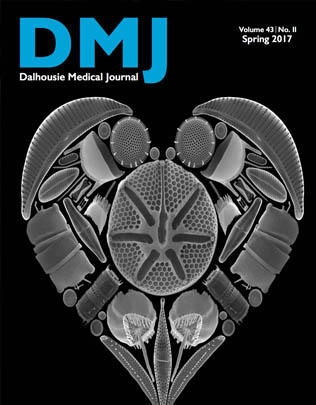Double dislocations in a single digit: a Canadian perspective
DOI:
https://doi.org/10.15273/dmj.Vol43No2.7055Abstract
Dislocation of both joints in the same digit due to a single insult is rare. To date there have been no reported cases from Canada. The purpose of our study is to review the literature and to survey plastic surgeons about this injury. We have contributed two case reports as well. Within six months, two patients presented to the Halifax Infirmary plastic surgery clinic for management of a double dislocation of a single digit. A comprehensive literature review of the English and non-English literature was performed. Additionally, a survey on experiences with double disloca- tions was developed and distributed to Plastic Surgeons practicing in Canada. 61 reported cases were identified in the literature, none of which were treated in Canada. 76% of cases were reported in English with the remaining 24% of cases reported in a non-English language (German, French). One hundred of the 373 members of the Canadian Society of Plastic Surgeons contacted replied (27%). Fourteen had previously encountered a double dislocation of a single digit. This injury was treated with closed reduction 90% of the time and splinting (65%) for two to three weeks. All patients regained normal range of motion with the exception of one. Ninety-three and 85% favored closed reduction and splinting, respectively. Two weeks was the preferred immobilization period (36%). We present the first reported cases of double dislocation of a single digit in Canada. We outline the etiology of this rare injury, previous treatments employed, and potential pitfalls encountered. The authors recommend a preferred treatment strategy for the management of double dislocation of a single digit.
Downloads
Published
How to Cite
Issue
Section
License
Authors who publish with this journal agree to the following terms:
- Authors retain copyright and grant the journal right of first publication with the work simultaneously licensed under a Creative Commons Attribution License that allows others to share the work with an acknowledgement of the work's authorship and initial publication in this journal.
- Authors are able to enter into separate, additional contractual arrangements for the non-exclusive distribution of the journal's published version of the work (e.g., post it to an institutional repository or publish it in a book), with an acknowledgement of its initial publication in this journal.
- Authors are permitted and encouraged to post their work online (e.g., in institutional repositories or on their website) prior to and during the submission process, as it can lead to productive exchanges, as well as earlier and greater citation of published work (See The Effect of Open Access).


